A Curiously Isolated Butterfly: Protecting One of Alberta’s Rarest Species
October 29, 2025
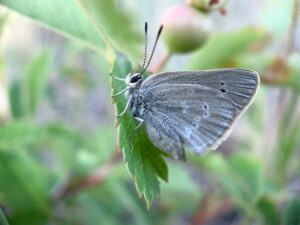
In the windswept grasslands of Waterton Lakes National Park, Alberta, a tiny butterfly is changing the way we see the natural world. This year, our Curiously Isolated Hairstreak Conservation Program made discoveries that are reshaping what we know about one of the rarest butterflies in the world. This elusive species’ fragile wings hold a powerful story of resilience and survival, and the impact of conservation work made possible by your support.
A New Name, A New Species
For years, the small, fuzzy, silver-tinged butterflies fluttering across the Blakiston Fan in Waterton LakesNational Park were thought to be an isolated population of the half-moon hairstreak, a species scattered across parts of Western North America. But earlier this year, a new chapter unfolded. Working with our partners and drawing on cutting-edge genetic sequencing and ecological modeling, we learned that this tiny population isn’t what we once believed. It’s something entirely new: a species so distinct it has earned its own name—the curiously isolated hairstreak (Satyrium curiosolus).
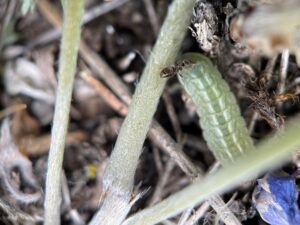
A curiously isolated hairstreak caterpillar gets a helping hand from a Lasius ponderosae ant—an interesting and important partnership in nature. The caterpillar benefits from the protection the ant offers from potential predators and parasites, and the ant gets to eat a sugary honeydew substance produced by the caterpillar.
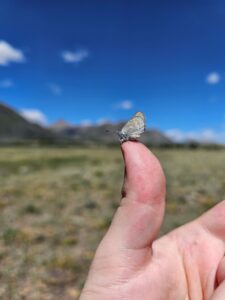
The isolated hairstreak butterfly is tiny, with inch-wide wings in warm browns and soft greys. Unlike its relatives in sagebrush habitats, it lives in prairie grasslands, relying exclusively on silvery lupine and forming a rare mutualistic bond with a specific ant species—an ecological partnership not seen elsewhere.
These findings not only highlight the species’ uniqueness but also underscore its vulnerability. This tiny butterfly exists only in one place on Earth: the Blakiston Fan of Waterton Lakes National Park.
To Translocate or Not to Translocate
For conservationists, the question now is how best to safeguard the future of this one-of-a-kind butterfly. Before its true identity was known, scientists considered whether “genetic rescue”—introducing butterflies from other populations to increase genetic diversity—might be a way forward. But the discovery that the curiously isolated hairstreak is both genetically and ecologically distinct from the half-moon hairstreak changed everything. Bringing in outsiders, it turns out, could do more harm than good.
What’s even more remarkable is what the research uncovered next: despite its low genetic diversity, this population has persisted—stable and resilient—for nearly 40,000 years. With that history in mind, conservation efforts are now shifting toward understanding the butterfly’s unique needs and exploring new strategies, including the possibility of conservation breeding, to help secure a future for this rare species.
Field Season Highlights
Here’s a glimpse into what we discovered during this year’s field season
JUNE
The team found more larvae than in previous years—a promising sign for the population. The caterpillars began pupating earlier than usual, and detailed habitat observations added to our growing knowledge.
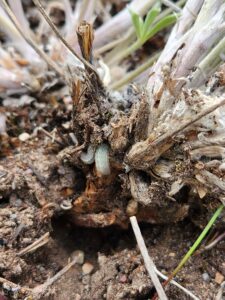
Nestled at the base of this silvery lupine (Lupinus argenteus) are some curiously isolated hairstreak larvae.
JULY
Three different butterfly monitoring methods we retested to refine population surveys. Adults emerged about 10 days earlier than average, and a few late butterflies lingered into the month.

The curiously hairstreak field team trialing a population monitoring method.
AUGUST
In a controlled setting, female hairstreaks successfully laid eggs on lupines cultivated by our horticulture team. About 20 eggs were brought back to the Wilder Institute/Calgary Zoo to overwinter, giving us a rare opportunity to study larval development under human care. This work lays the groundwork for potential conservation breeding and translocation programs—essential steps in protecting the species from extinction.
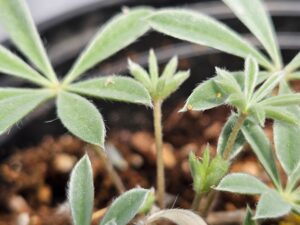
A curiously isolated hairstreak egg laid on the tip of a silvery lupine leaf. This silvery lupine is growing in a pot and will overwinter under the care of our horticulture team.
A Caterpillar That Glows
Among the season’s most fascinating findings? One that can’t be seen with the naked eye! When exposed to ultraviolet light, the hairstreak’s caterpillars and pupae emit a pale, eerie blue glow—likely caused by fluorescent compounds absorbed from the plants they feed on. While we know how this happens, the why remains a mystery. Many insects can see further into the ultraviolet spectrum than humans, so this glow might help other species identify the caterpillars.
This discovery—like something out of a deep-sea documentary rather than a mountain meadow—has given researchers a whole new way to see and study this extraordinary species. And it’s discoveries like these that your support helps bring to light—making a real difference for even the smallest species in need.
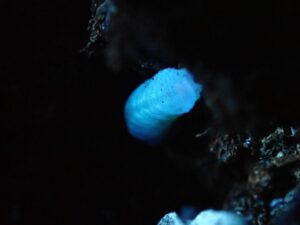
A larva fluorescing under UV light.
Looking Ahead
With the recognition of the curiously isolated hairstreak as a distinct species, the urgency to protect it has never been greater. Our next steps may include establishing an assurance population and piloting conservation breeding—work that could ensure this butterfly continues to flutter across the meadows of the Blakiston Fan in Waterton Lakes National Park for generations to come.
The discoveries of this past year have shown us just how extraordinary—and fragile—this butterfly truly is. And it’s only through the dedication of our field teams and the generosity of supporters that this work is possible.
Donate today to contribute to conservation efforts and programs like the curiously isolate hairstreak. Together, we are uncovering the secrets of one of Alberta’s rarest species and taking meaningful steps to secure its future.
